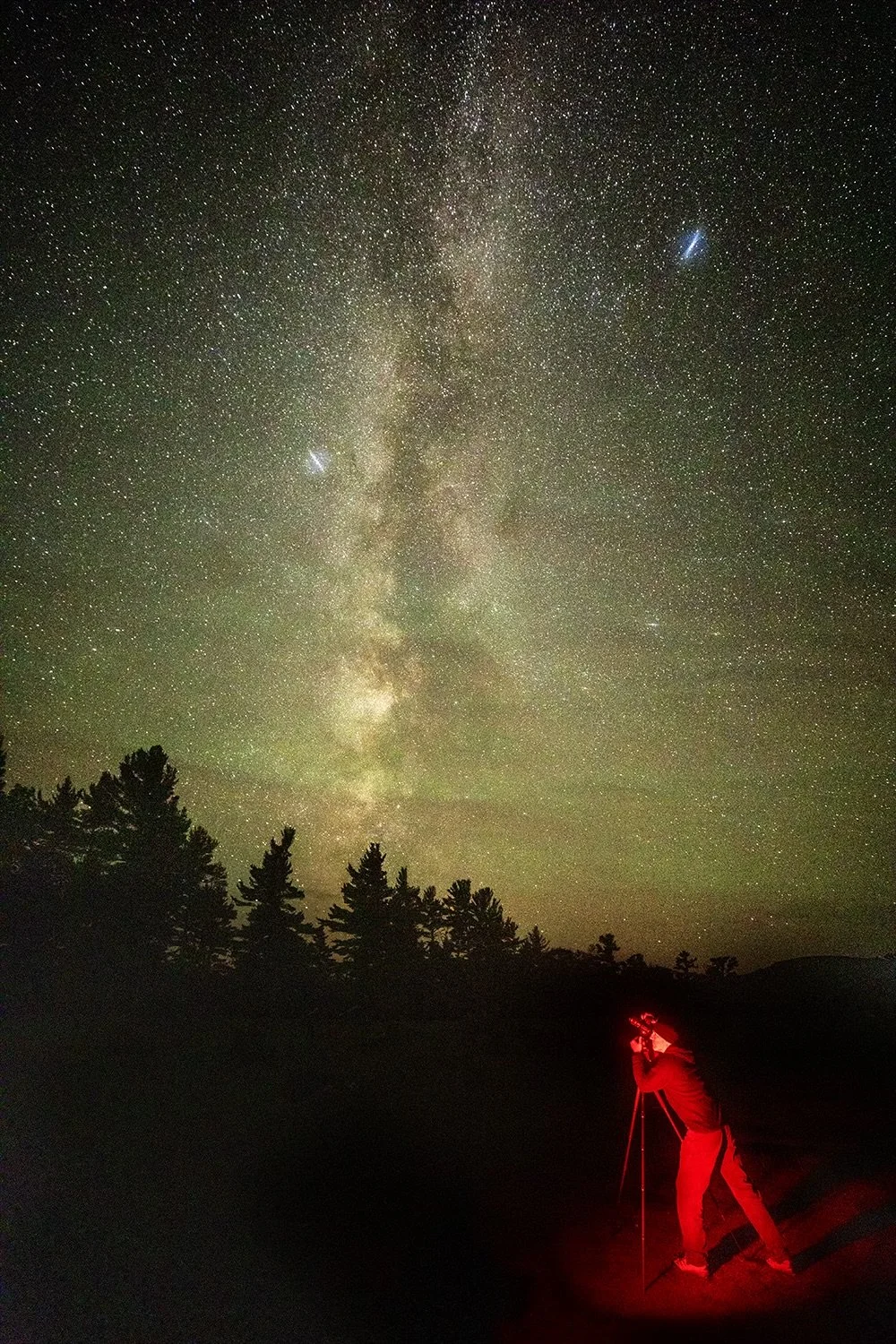Ever wonder why I ask you to bring a red flashlight or headlamp on night hikes or photography outings? It’s not me being quirky, it’s actually rooted in science. If you’re heading out under dark skies in the Keweenaw, understanding how light affects your eyes (and others around you) will help you see more stars and capture better images.
Why Do I Recommend Red Flashlights for Night Activities?
Red flashlights help preserve your natural night vision. Unlike white or blue light, red light has minimal impact on the chemical processes your eyes rely on to adjust to darkness. That means you’ll be able to see stars more clearly, spot faint auroras sooner, and move around confidently without blinding yourself or the people around you.
Let’s delve into why that matters and how it works.
How Human Night Vision Actually Works
A diagram representing the retinal layers, including the location of cone cells and rod cells (which contain the rhodopsin, a protein critical for night vision). Image obtained from Anatomy & Physiology, Connexions Web site and is is licensed under the Creative Commons Attribution 3.0 Unported)
1. Your Eyes Are Built for Both Day and Night
The human eye contains two main types of light-sensitive cells:
Cones (centered in the retina) help us see color and detail in bright light
Rods (concentrated on the periphery) let us see in low-light gray-scale and detect motion
This dual system evolved to help humans survive both day and night. Making them able to scan for subtle movement in the shadows or notice the color of ripe berries under daylight.
2. Rod Cells Rely on a Special Pigment
Rod cells contain rhodopsin, a light-sensitive pigment that lets us see in the dark. It’s so sensitive, it can respond to a single photon of light. But here’s the catch:
Bright light (especially white or blue) breaks down rhodopsin,
it takes 20–40 minutes to fully regenerate, and
even just a few seconds of bright light can reset your eyes' ability to not see in the dark
3. Red Light Doesn’t Activate Rhodopsin
Deep red wavelengths don’t affect rhodopsin the same way white, green, or blue light does. So, when you use a dim red light:
Your rod cells stay adapted to darkness,
you keep your night vision intact, and
you’re less likely to disturb others nearby
That’s why astronomers, wildlife guides, and ethical night photographers all swear by red light.
Red Flashlight Etiquette: How to Be a Good Stargazing Neighbor
If you’ve ever had your night vision wrecked by a sudden phone screen or headlamp beam, you know how frustrating it is. The following practices ensure a better experience for everyone on the trail, on the ridge, or beside the lake:
Flashlight Best Practices for Dark Sky Activities
Use red light only: White lights, even briefly, destroy night vision
Don’t point your light at others: Especially if it’s on your headlamp. Be mindful when turning to look in another direction.
Dim your screen brightness: Cover your phone or camera LCD with your hand or dim screen mode
Use hand-shielded lighting: Let just enough red light leak between your fingers when adjusting gear
Cover unnecessary indicators: Use gaffer tape to mask camera record lights or LED glows
Avoid casting red light toward photographers: Even red light can ruin a long exposure. The unnatural red color cast is nearly impossible to remove in post-processing, especially during aurora or Milky Way photography. If you see someone with a camera on a tripod, move behind them or turn your light off briefly while passing.
🎯 Want more tips? See my Night Sky Photography 101 guide (placeholder for when the page goes live)
How to Make Your Own Red Flashlight
If you don’t have a flashlight that emits red light…no problem. Here are a few simple DIY options:
Red cellophane + rubber band: Wrap it around your flashlight lens
Red zip-top bag: Works in a pinch. These colors of bags usually are most available around the Christmas season.
Red permanent marker : Color the lens of an old flashlight
Buy a headlamp with red mode: I recommend tis for convenience and safety.
Keweenaw-Specific Considerations
In Michigan’s Keweenaw Peninsula, true darkness still exists. Whether you're photographing from Esrey Park, camping near High Rock Bay, or watching for auroras anywhere along Lake Superior’s shore, these landscapes reward those who protect their eyes (and, as a bonus, respect their fellow explorers).
Even the full moon here can cast shadows, and a well-adapted eye is your best tool for navigating roots, snowdrifts, or shoreline rocks.
Final Word: Night Vision Is Worth Protecting
There’s a reason why seasoned astronomers and aurora chasers go red. Once you’ve spent a few minutes adjusting to the dark and start to see subtle greens, purples, or the sweep of the Milky Way you’ll understand why it matters.
“Watching the Perseids after 20 minutes of quiet waiting was one of the most peaceful and thrilling experiences of my life.” — KML Guest, 2023 Perseid Meteor Shower Viewing Party
So please: bring a red light. Use it wisely. And help keep the dark sky experience alive for everyone.
Internal Links
Night Sky Photography 101 (placeholder for when the page goes live)
How to Prepare a Night Sky Explorer Kit (placeholder for when the page goes live)
Photography Excursion FAQs (placeholder for when the page goes live)
External Authority Sources
Get Ready for the Dark
Download my Red Flashlight Guide (PDF) [coming soon]
Book a Guided Night Photography Outing »

